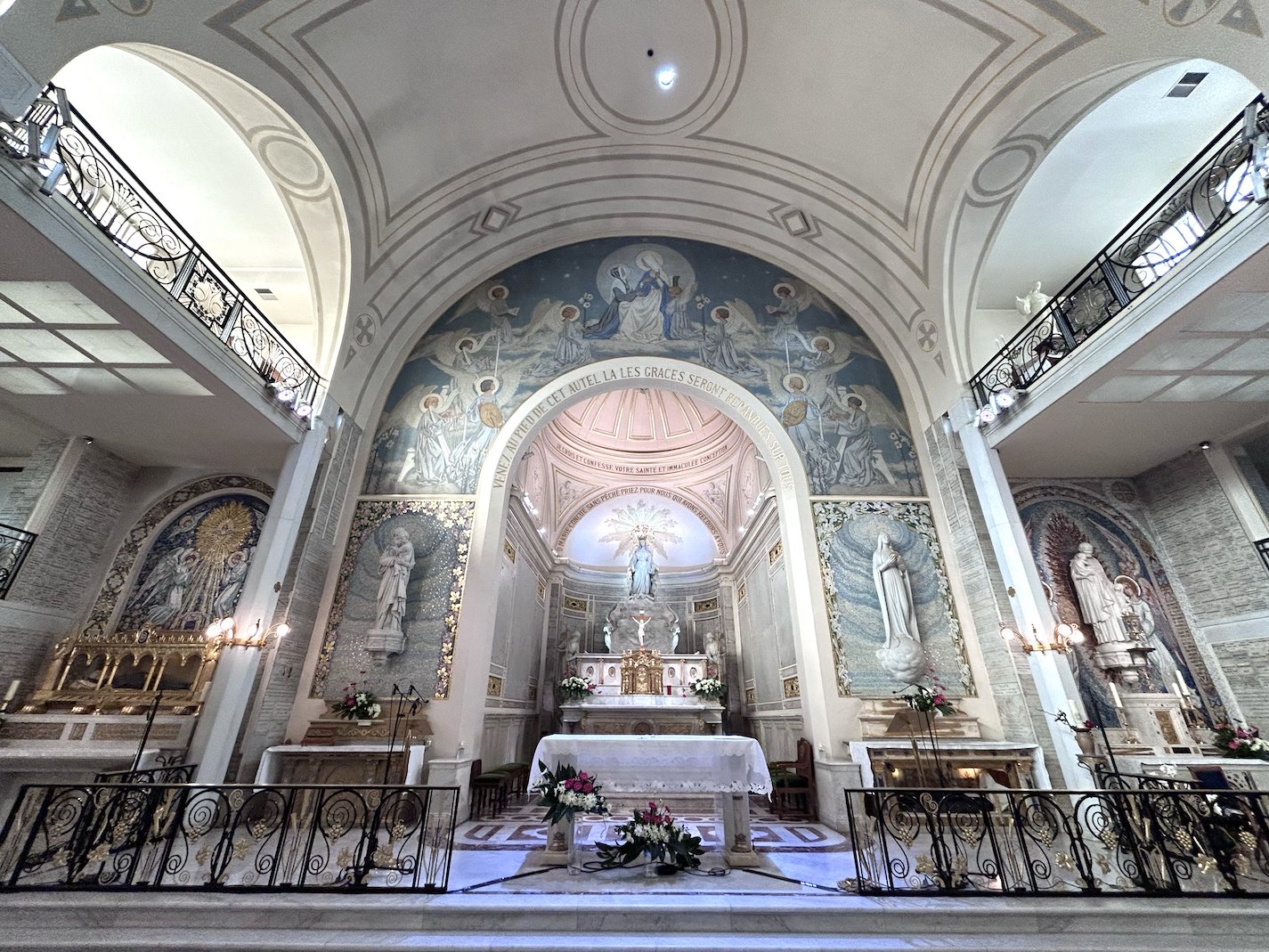It’s been 350 years since the creation of the first diocese in North America north of Mexico. The Archdiocese of Quebec, established in 1674, originally had within its boundaries most of the territory now in the United States. The see city, founded in 1608 by French explorer Samuel de Champlain, is one of the oldest European settlements on the continent and draws its name from the Algonquin word “Kebec” — which means “where the river narrows” — referring to the city’s location near where the St. Lawrence River tapers down from the gulf of the same name.
The archdiocese traces its roots back to the early French missionaries and explorers, and it was critical in advancing the spread of the Gospel in the Quebec colony and abroad. In fact, the seeds of faith planted in Quebec — through great sacrifices and heroic witness of a variety of historic and saintly figures — are largely responsible for the growth of Catholicism on the continent as a whole.
Built by a holy bishop
The first of these is St. François-Xavier de Montmorency-Laval, whose brave missionary work as the first bishop of the Archdiocese of Quebec led to the flourishing of the local Church. François oversaw a territory encompassing most of the continent with bold faith and a missionary heart, and he planted the seeds of Catholic faith in the New World.
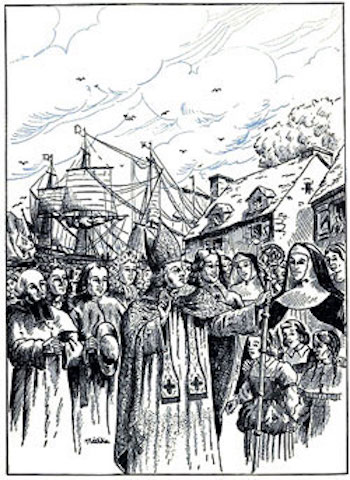
Born into a family of nobility in 1623, François’ formative years were filled with stories of Jesuit missionaries in North America. François was so impressed by their missionary zeal that he considered joining their ranks. But in 1647, he instead was ordained a diocesan priest, seemingly putting an end to his missionary ambitions.
A three-year stint at a retreat house at Caen, France, is where François’ reputation grew, not only as a man dedicated to prayer and works of charity, but also as a reformer. Bishop François de Servien of Bayeux described the zealous priest to be of “great piety, prudent and of unusually great competence in business matters, (and) fine examples of virtue.” With these qualities, François was appointed apostolic vicar to New France.
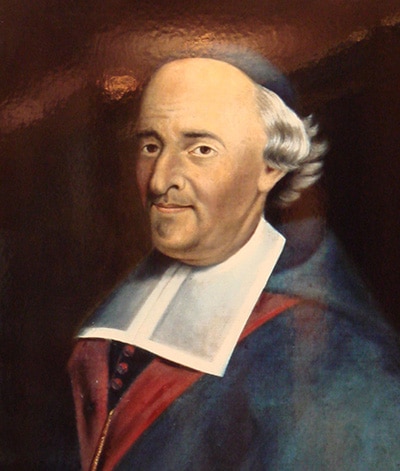
French exploration and colonization in the New World, which had begun nearly a half-century earlier, had necessitated a bishop’s ministry by the time of François’ appointment in 1658 — which previously had been under the jurisdiction of the archbishop of Rouen, France. François’ authenticity and integrity were obvious, and he was regarded as pastor par excellence from the first moments with his new flock. Diligent in administering the sacraments, François was particularly dedicated to care for the sick from the start of his Quebec ministry. His life as bishop also was marked by simplicity and poverty, and he was generous with the poor. “He gives away everything and lives in poverty,” St. Marie Guyart said of François. “His home, his life, his furnishings, his servants are all a reflection of how he lives his life in poverty.”
During his time as bishop of the Archdiocese of Quebec, François was responsible for building an ecclesiastical infrastructure. Parishes and hospitals were constructed at his direction. He was a great proponent of building a strong educational system for all, not just the elite. The project of which he was the proudest was the Grand Seminaire, founded in 1663 to support the Church of New France by training future priests and leaders. François was met with great resistance when he levied an ecclesiastical tax on parishes and farms in order to provide for the upkeep of the seminary. The seminary eventually evolved into François University, the oldest institution of higher education in Canada.
“Immediately after his [François’] death the people canonized him, as it were, having had the same veneration for his body as for those of the saints.”
François’ position within the Church required that he be involved in a certain amount of colonial politics, and he was never afraid to disregard civil authority when needed. He boldly defended civil rights in the New World, especially among the indigenous. Recognizing the destructive behavior among Native Americans when introduced to alcohol, he excommunicated those who sold it to the indigenous. His decision was supported by a royal decree in 1679.
As François’ health deteriorated, he resigned his office in 1688. He spent several years in retirement dedicated to a life of prayer and service to the poor. François died in 1708 after developing a stomach ulcer. An observer of his funeral noted, “Immediately after his death the people canonized him, as it were, having had the same veneration for his body as for those of the saints … they even cut off pieces of his robe, which several have had enshrined in silver, and they treat them as relics.” François finally was declared a saint by Pope Francis in 2014. His feast day is May 6.

First woman evangelizer
The first woman to evangelize North America, Marie Guyart, was a baker’s daughter born in Tours, France, just before the turn of the 17th century. A mystic from an early age, Marie once saw the Lord appear to her and express his desire that she be completely, totally his. She replied wholeheartedly, “Yes!”
Despite a draw toward religious life early in life, Marie married a silk dealer at age 17. Widowed two years later, and with a 6-month-old son, Marie was left to handle the fallout from her husband’s bankrupt business. Turning down other offers for marriage, the widow made a vow of chastity instead. To provide for herself and her son, she relied on her embroidery skills and worked for her brother-in-law’s business. Despite the time needed for her entrepreneurial pursuits, Marie made time for daily Mass and prayer.

The most drastic change in Marie’s life came when she was in her late 20s. It was at that time when she discerned the Lord was calling her to religious life. This required leaving her son in the care of her family, a difficult decision that nonetheless enabled her to enter the novitiate of the Ursuline order. She took vows as Sister Marie de l’Incarnation in 1633.
A mystic from an early age, Marie once saw the Lord appear to her and express his desire that she be completely, totally his. She replied wholeheartedly, “Yes!”
Sister Marie did not stay in the French convent for long. A mystical experience revealed to her a beautiful and scenic land. God told her: “It was Canada that I showed you; you must go there to build a house for Jesus and Mary.” She henceforth became absorbed with the desire to spread the Gospel in the New World.
Having learned from Jesuits about missions in New France, Sister Marie set out for Quebec in 1639 with a small group, including another Ursuline. Her business skills proved very useful as she began a school for Native American girls — a school that was the first educational institution for women in North America. Sister Marie of the Incarnation was an evangelist and missionary in the truest sense; she even learned four languages and developed dictionaries to share the Gospel and educate the indigenous. She also built the first monastery on the continent, and was superior and novice mistress for the growing order. The thousands of extant letters written during Marie’s time in Quebec offer a unique testimony of the early days in the colony.
Sister Marie was acquainted with great suffering, manifested by a variety of illnesses, including a long-term battle with liver disease. She also wrote regularly to her son — who went on to enter the Benedictines and who kept in regular contact with his mother through moving, heartfelt letters.
Marie died in the presence of her community on April 30, 1672. On her deathbed, she made sure that word would be sent to her son: “Tell him that I am carrying him with me in my heart.” Upon hearing the news of her death, her saddened bishop St. François Laval eulogized, “Jesus Christ possessed her so completely … that she lived and acted only through Jesus Christ.” Along with Laval, she was canonized in 2014. Her feast day is April 30. A wing of Quebec’s Ursuline monastery is home to the Centre Marie-de-l’Incarnation. The centre offers exhibits for those desiring to learn more about the saint and hosts some objects that had belonged to her. In a side chapel of the monastery’s historic chapel rests the tomb of the saint.
Quebec’s first mystic
Catherine de Longpré was intent on doing God’s will from an early age. Her maternal grandparents, who raised her, helped her connect that desire to a life of self-sacrifice and care for the poor. Born in Normandy, France, in 1632, Catherine was influenced by the Jesuit missionaries to North America who were in great number at the time. Her lifelong mystical experiences began at age 5.
Precocious and cheerful, attractive and intelligent, Catherine was drawn to a worldly life until, at 12, she decided to enter the monastery of the Canonesses of St. Augustine at the Hotel-Dieu of Bayeux, taking the name Catherine of St. Augustine as she entered novitiate. Her beloved grandmother would later join her there as well.
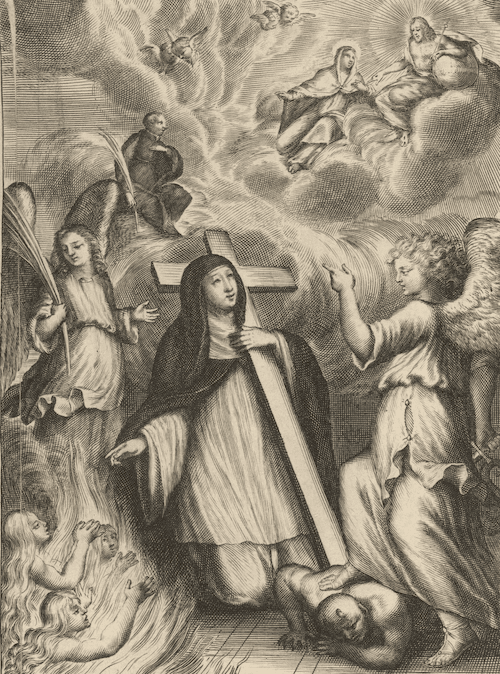
Catherine spiritually offered her life completely for the Church’s mission in Quebec, promising God to live and die in Canada if God would open the door for it to happen. She set sail for Quebec the following year, joining the mission where her congregation established Quebec’s first hospital. Quickly learning the indigenous languages required to evangelize and care for the sick and suffering, Catherine took as a special patron St. John de Brebeuf — who had appeared to her — just after his martyrdom in 1649.
“I don’t need to see any extraordinary signs from her [Catherine de Longpré] to be convinced of her holiness, because her virtues made me perfectly aware of it.”
St. François de Laval
Catherine’s spiritual life was intense, with mystical experiences continuing, alongside intense temptations and sufferings and weak health. Nonetheless she was an accomplished leader, having at different times taken on important positions in her community and its mission.
In 1658, Catherine offered her life in reparation for the salvation of New France, and is hence regarded as a co-foundress of the Church in Canada. Catherine was motivated to do this by her sensitivity to the evil and sin she witnessed in society, as well as a profound solidarity with sinners: “I found myself overwhelmed by the intolerable weight of all the crimes I witnessed. … I let it draw me into being helpful to souls.” She saw the damage caused by the sale of alcohol in Quebec, including the violence it induced among indigenous people. She offered her suffering to Jesus with a prayer that it would evoke God’s mercy on the fledgling colony.
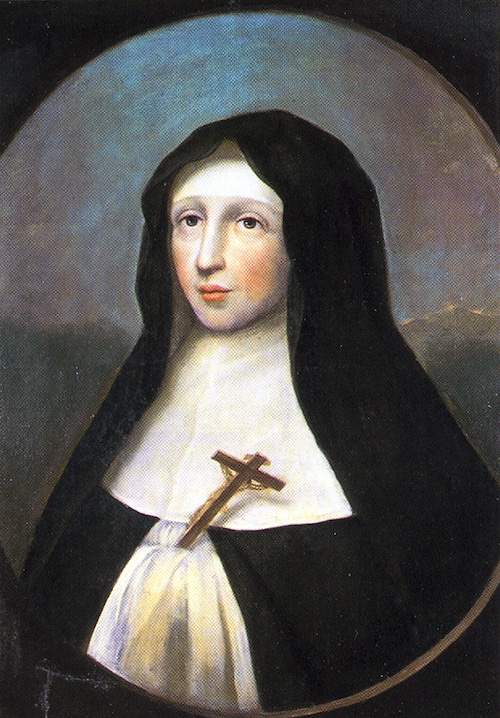
In 1665, Catherine pledged to work for “everything that I know to be most perfect and for the greater glory of God.” After another brief illness, Catherine died on May 8, 1668, at age 36. In her death, she was reputed for holiness. St. François de Laval, well aware of Catherine’s inner life and trials, said upon her death, “I don’t need to see any extraordinary signs from her to be convinced of her holiness, because her virtues made me perfectly aware of it.” Catherine was beatified in 1989 and her feast is May 8.
The Centre Catherine-de-Saint-Augustin is housed in Quebec’s Monastere des Augustines, where pilgrims can learn a great deal about the holy woman’s spirituality and contributions to early ecclesial life in Quebec. Catherine’s relics are in a side chapel of the monastery’s historic turn-of-the-19th-century chapel, as well as a portion of the skull belonging to her mystical patron, St. John de Brebeuf. On the other side of the sanctuary is another side chapel with the historic statue Notre-Dame de Toutes-Graces (Our Lady of All Graces), which was received after sailors made a vow and were saved from shipwreck in 1738.

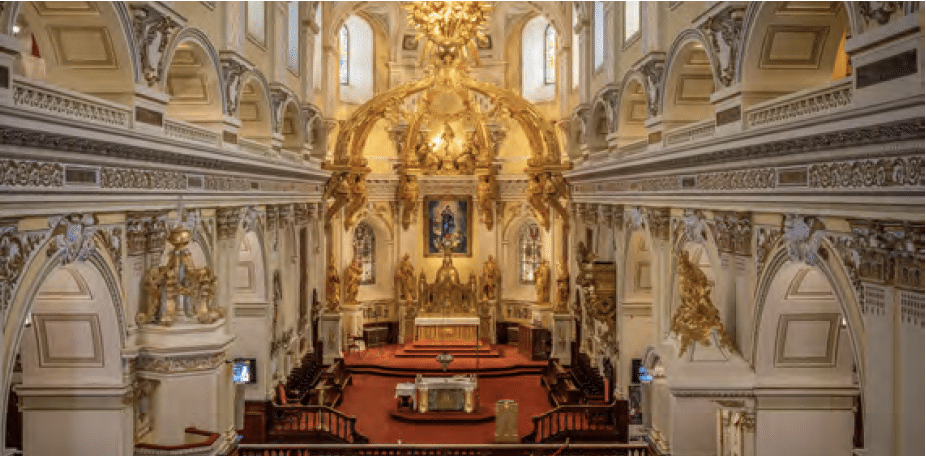
Quebec’s cathedral
Tracing its roots back to a chapel built in 1633 by Samuel de Champlain, this historic cathedral of Quebec City was first built in 1647. Since its initial construction, the cathedral has endured multiple fires and reconstructions. Initially serving as a parish church, the building was designated as the cathedral with the creation of the then-Diocese of Quebec in 1674, and it received status as a minor basilica exactly 200 years later. Several early governors of New France are buried in the cathedral, as are most of Quebec’s bishops, including St. François de Laval. The cathedral is also home to the Centre d’animation François-De Laval, which offers a permanent exhibit about the saintly founder’s life, work and spirituality. In 2013, the cathedral became home to the first officially designated holy door outside of Europe. The holy door opened last December and is expected to remain open for the 2025 Jubilee Year. More information can be found at holydoorquebec.ca.

Notre-Dame-des-Victoires
The small stone chapel of Notre-Dame-des-Victoires is situated in Old Quebec, built atop the site of the first permanent French establishment in North America. Originally dedicated to the Infant Jesus at the time of its inception in 1687, the chapel received the title of Our Lady of Victory after dual retreats of British invaders in 1690 and 1711.
Ste. Anne de Beaupre
With origins dating back to 1658, the Basilica of Ste. Anne de Beaupre, situated about 20 miles northeast of Quebec City, is renowned as a place of prayer, pilgrimage and miracles dedicated to the savior’s grandmother. From the construction of its very first chapel on the site in the 17th century — which was used to house a miraculous statue of St. Anne brought to New France by settlers — the shrine has seen countless miracles and healings. The visible reminders of these many healings, which include canes, crutches and other implements used by those suffering disabilities, are attached to various walls in the current church. Within the first decades of its existence, the shrine became a popular pilgrimage site for indigenous Americans, who honored St. Anne as an elder, calling her our “Grandmother in the Faith.”
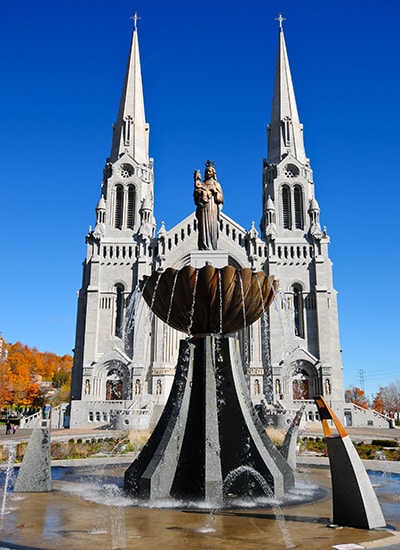
French explorers, missionaries and seafarers brought to North America a particular devotion to St. Anne, who has become the patron saint of the Canadian province of Quebec. The shrine houses three significant relics of the mother of the Blessed Virgin Mary. A portion of a finger bone belonging to St. Anne was brought to the shrine in 1670 by St. François de Laval. A piece of a forearm of St. Anne was given to the shrine by Pope Leo XIII in 1892. And a second forearm relic was given to the shrine as a gift of Pope John XXIII.
Montreal
Not long after ecclesial life began developing in Quebec, its fledgling foundation in present-day Montreal also was beginning. The Ville Marie colony was founded in 1642 upriver from Quebec, on an island in the St. Lawrence River. While Quebec was the center of civil and ecclesiastical government, Montreal grew over time in prominence and importance. While it became an outpost for fur trading, the colony was founded in part as a missionary enterprise to evangelize the indigenous populations. Montreal eventually became its own diocese in 1836 and was elevated to an archdiocese in 1886.

Among the founders of the VIlle Marie colony is St. Marguerite Bourgeoys. St. Marguerite joined the mission at Ville Marie in 1653, where she founded the Congregation de Notre-Dame, (one of the first successful uncloistered communities for women), established the first public school and built the first permanent church in Montreal, a chapel dedicated to Notre-Dame-de-Bon-Secours. Marguerite was canonized in 1982, and her body rests in the current structure built on the site of the first chapel she constructed.
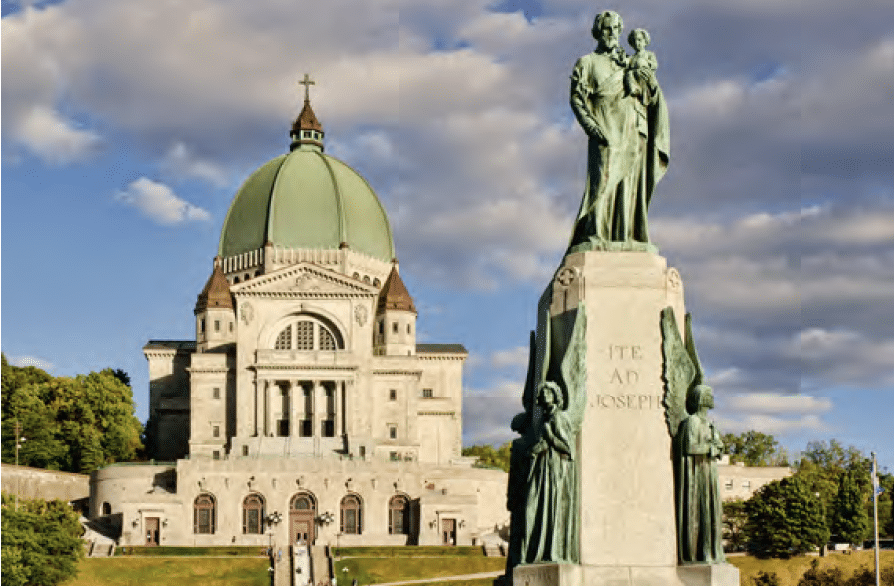
Montreal is also home to the impressive St. Joseph Oratory, founded by Holy Cross Brother Andre Bessette. The largest church in the world dedicated to St. Joseph, the oratory is also the largest Catholic church in Canada. The oratory began when Bessette, canonized a saint in 2010, entrusted the scores of sick, broken and needy people to the intercession of St. Joseph while serving as porter at a college operated by his congregation. Eventually, Bessette realized the long-held dream of building a shrine to honor St. Joseph and give pilgrims a place to come to seek his intercession. St. Andre Bassette’s body rests in a small chapel in the oratory’s crypt level.




